Pamela S. Kan-Rice, UC ANR

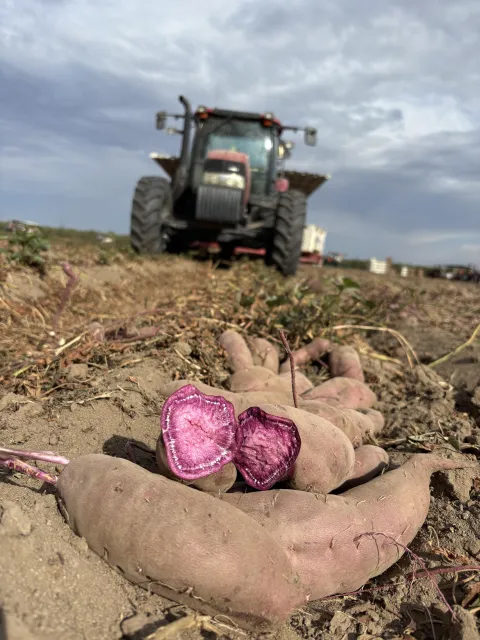
This is the cultivar “Regal Purple” from South Carolina.
Alongside a roasted turkey and stuffing, a traditional Thanksgiving meal usually includes sweet potatoes glazed with butter and brown sugar and topped with toasted mini marshmallows. While most sweet potatoes are yellow or orange, purple sweet potatoes are starting to add a touch of royal color to the holiday dining table.
“There’s a lot of interest in the purple sweet potato,” said Scott Stoddard, University of California Cooperative Extension farm advisor in Merced County. “It’s creating buzz, something new to talk about.”
When West Coast consumers go to a grocery store to buy sweet potatoes for Thanksgiving, chances are good that they will be choosing sweet potatoes grown from clones of mother plants propagated at UC Davis Foundation Plant Service that were selected by Stoddard.
Stoked for Stokes and other purple varieties
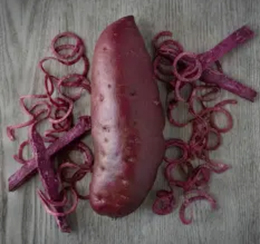
Stokes Purple
Five years ago, a few growers were dabbling in purple sweet potatoes. Now about 1,000 acres of purple sweet potatoes are being grown in California.
Stoddard said at least six varieties of purple sweet potatoes are being grown, but noted growers are cagey about what they have planted because they hope to cash in on something special.
“Right now, it’s the wild, Wild West,” he explained. “Nobody will tell you what they’re growing. It’s like, ‘my purple is better than your purple.’”
Two purple-skinned varieties with purple flesh, Stokes Purple and Ben Yagi, are owned by a company. Another variety is a promising unpatented experimental variety that Stoddard calls Purple Rayne. The others are experimental varieties Purple Majesty, Purple Splendor and Regal Purple.
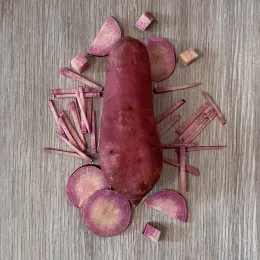
Ben Yagi
“Eventually we’ll settle on one or two varieties,” Stoddard said.
Farmers in Hawaii grow Okinawan, a sweet potato with white skin and purple flesh, but in California it doesn’t yield enough for growers to be economically sustainable.
“The purple/purple [varieties with purple skin and purple flesh] trend started with Stokes,” said Stoddard.
Introducing the uncommonly colored varieties required educating retailers, recalled Jeremy Fookes, director of sales for A.V. Thomas Produce Company, which owns the dark purple Stokes Purple and lighter purple Ben Yagi. Because the Stokes Purple has a drier flesh, they need to be cooked about twice as long as the moist orange flesh varieties.
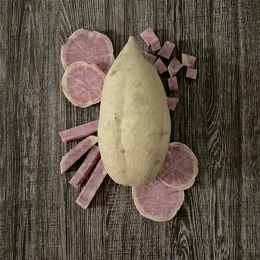
Okinawan
“The first couple of years were a challenge,” said Fookes, who started growing five acres of purple varieties in 2012. “Stokes has to be cooked longer in order to make it moister inside, otherwise it can be chalky or pasty if you don’t cook it long enough.”
For assistance with sales and marketing. the company partnered with Frieda's Specialty Produce in Anaheim, which is well-known for its unique produce.
In 2023, “Live to 100: Secrets of the Blue Zones” – a Netflix documentary that examined five regions of the world where people live extraordinarily long and healthy lives – piqued interest after a featured source spoke highly about purple sweet potatoes for containing the phytonutrient anthocyanin.
As a result, requests for their purple sweet potatoes “took off,” Fookes said. His company now grows over 500 acres of its Stokes Purple in California organically and the premium variety is carried by large commercial grocers and independent stores across the country and even shipped to the Middle East.

Scott Stoddard holds Bonita, a variety with cream-colored flesh that is planted on about 10% of California's sweet potato acreage.
Sweet potato industry slumps after pandemic
California sweet potato growers, who produce about 25% of U.S.-grown sweet potatoes, need something to get excited about. Following the 2020 COVID-19 food-supply disruption, the sweet potato industry suffered setbacks. In California, 85% of sweet potatoes are sold for fresh market and the rest are used for French fries or baby food.
“We thought sweet potato fries would take off,” Stoddard said. “It was ramping up, then quit and flatlined.”
Consumers didn’t buy as many sweet potatoes so prices stagnated as input costs – for labor, fertilizer, new regulations and other expenses – climbed for the labor-intensive crop.
“Every sweet potato is touched by a hand,” Stoddard said. “Sweet potatoes are dug out by a machine harvester, but individually placed by hand into bins. Later, those bins are brought out of storage, then packed by hand into a box that goes to the store.”
Most California sweet potatoes are grown in Merced, Stanislaus and Kern counties. Over the past five years, acreage in California shrank from over 21,000 acres to about 18,000 acres as growers planted other crops. Four sweet potato packing sheds closed.
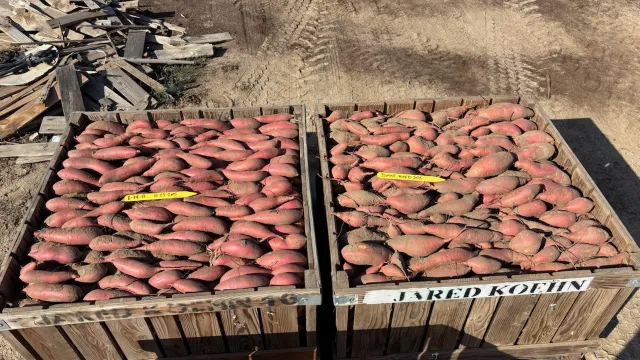
Stoddard on decades-long quest for better sweet potato varieties
Growers are feeling more optimistic about the future with improved varieties.
In 2002, when Stoddard joined UC Agriculture and Natural Resources as a UC Cooperative Extension vegetable crops advisor for Merced County, he surveyed local growers to help establish his research priorities. They wanted a new red sweet potato variety to replace the Diane variety.
“Diane yields well, but it is susceptible to root knot nematodes and does not store well,” Stoddard explained.
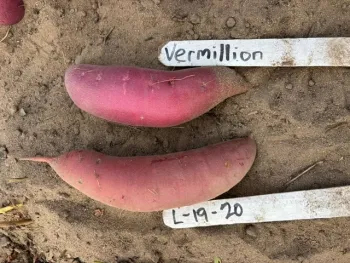
Color comparison of Vermillion, top, to a new experimental variety
For nearly 25 years, Stoddard has been seeking a better red sweet potato variety to replace Diane. He thought he found the answer with Burgundy, released in 2014, but the red-skinned variety didn’t perform as well for growers as it had in his test plots.
“It was not successful as it didn’t yield for anybody even though my field plot data said otherwise,” he lamented.
In 2021, another red-skinned variety with bright orange flesh was released as an alternative to Diane. Vermillion is now grown on about 10% to 15% of California sweet potato acreage.
“Some growers really like it because it stores well,” Stoddard said. “If you have a good storing variety, it pays dividends in June. But some have problems getting it to yield so they don’t like it. So my quest continues!”
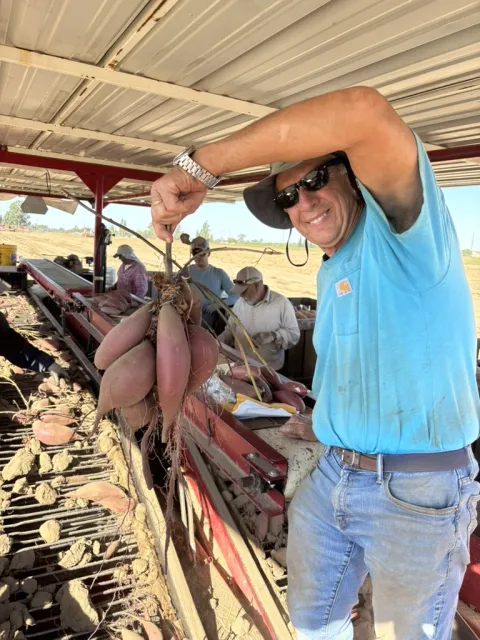
Louisiana State University professor and sweet potato breeder Don La Bonte holds up one of his new red lines (red skin with orange flesh) harvested in October 2025 in Atwater, California.
Collaboration with LSU breeder produces high-yielding varieties
Because there are no sweet potato breeders in California, Stoddard collaborates with Louisiana State University professor and sweet potato breeder Don La Bonte, who sends about 30 varieties to California each year for screening.
“Four of the six most important commercial sweet potato varieties grown in California started with the LSU breeding program,” Stoddard said.
“I stick them in the ground in May and see what comes out,” said Stoddard, who tests about 40 new lines every year with grower cooperators. Potential new lines are selected based on shape, color, flavor and potential yield. For the second year of testing, only three to five varieties move forward.
It’s important to test the varieties in different growing regions because they perform differently, he said, noting that La Bonte thought Bellevue didn’t look good in Louisiana so he threw it out. “I had to send it back so he could propagate it again,” Stoddard recalled.
Bellevue was formally released in 2015 and Stoddard estimates it comprises around 15% of California sweet potato acreage. Originally created in 2006 by LSU breeder La Bonte, the variety entered California trials in 2008. Stoddard evaluated Bellevue for seven years before it was made available to the growers, which is a common timeline for bringing a new variety to market. In addition to yield and storability, he looks for vulnerability to pests and diseases.
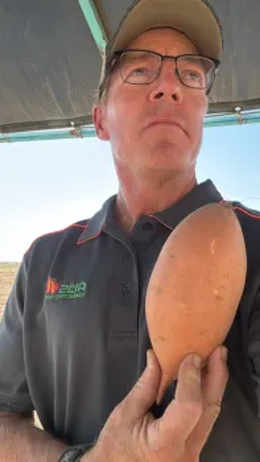
Bellevue, with orange skin and flesh, is planted on about 15% of California sweet potato acreage.
His research found that cracking occurred in Bellevue when harvested in cold temperatures. He recommends harvesting it before Oct. 15 and in the warm afternoon to avoid losing crop to cracking.
The sweet potato with orange skin and bright orange flesh and resistance to root knot nematodes has achieved some international success, and is now grown in Canada, Netherlands, Portugal, Spain, Egypt, Australia and New Zealand.
Bellevue and other high-yielding orange flesh varieties, Vermillion and Diane, account for about two-thirds of California sweet potato production. Other popular varieties are the sweet, white flesh Murasaki and Bonita.
Stoddard sees promise in the purple/purples for California growers.
“We’re moving away from orange flesh varieties,” he said. “We’re not growing varieties that others can grow.”
California growers have also created a niche for organically grown sweet potatoes. “We’re about the only production area that can grow organics profitably,” Stoddard said, noting that insects rob growers of yields in Louisiana, Mississippi and North Carolina. “We frequently don’t have to use insecticides in California.”
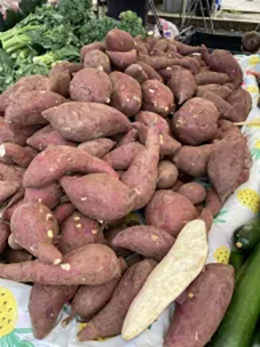
Murasaki
Instead, California growers suppress nematodes, grubs and other soil-borne pests by dry fallowing, leaving fields unplanted every other year.
‘Low and slow’ cooking best for sweet potato flavor
When cooking a yellow or orange variety, Stoddard, who also evaluates sweet potato varieties for their eating quality, recommends baking them for an hour at 375 degrees F to caramelize the starches to bring out the best flavor.
“While Ben Yagi Purples cook like other moist flesh varieties, the Stokes Purple sweet potato should be cooked low and slow,” said Fookes of A.V. Thomas Produce Company. He bakes them for 90 minutes to two hours between 250 and 275 degrees Fahrenheit. He advises against microwaving sweet potatoes because the cooking process doesn’t create the same flavors.
“You only get caramelization through the low heat, slow baking process, whether it’s foil-wrapped on a barbecue or in a pan in the oven,” Fookes said.
